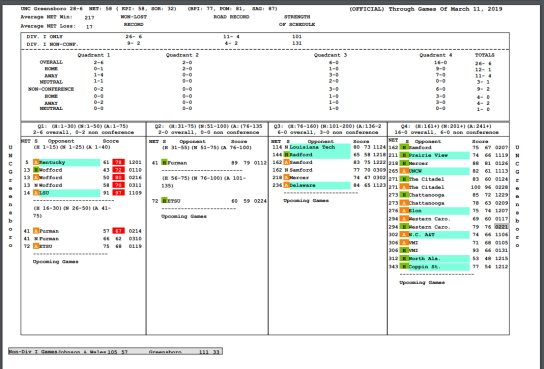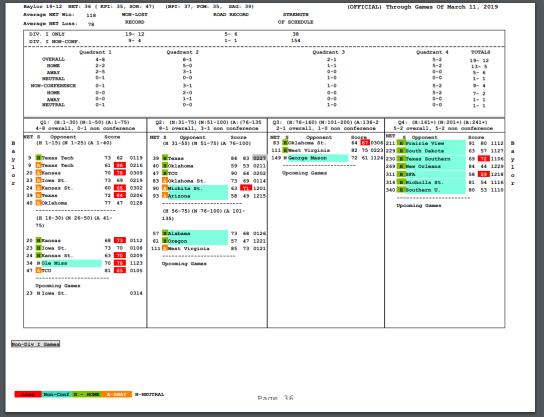“You are what your record says you are.” -Bill Parcells
In the world of college basketball, it’s a bit more complicated. Teams play wildly disparate schedules. Abilene Christian and Michigan State are both 23-6. We know that Michigan State has played a tougher schedule than Abilene Christian, but can we quantify that difference? Yes, but let me first define a few terms:
Pythag: Pythag (short for Pythagorean Win Expectation) is your expected win percentage against an average D1 team on a neutral court.
Parcells: The Pythag required for your record to be the median expectation. It’s quite literally what your record says you are.
WAB: Wins-Above-Bubble. The amount of wins you have minus the amount of wins an average bubble team would expect vs. your schedule.
You can find all the data available here:
https://docs.google.com/spreadsheets/d/1qmdUR_iMWIUzMBQvMwGBP-EV_64f59kaGUOVUAiKO60/edit?usp=sharing
Abilene Christian went 0-1 in quadrant one games, 0-0 in quadrant two games, 2-2 in quadrant three games, and 17-3 in quadrant four games. They also went 4-0 in games not rated by the NCAA.
Michigan State went 10-4 in quadrant one games, 4-2 in quadrant two games, 5-0 in quadrant three games, and 4-0 in quadrant four games.
Abilene Christian played one very tough game this season, at Texas Tech. They lost by 34. The question remains: can we quantify the difference between the two resumes? The answer is yes.
We have a few different tools at our disposal. One option is to put hypothetical team through both schedules and see how many games they would expect to win. So, just how hard has Michigan State’s schedule been? If you put roughly the 50th best team in the country against their schedule, they’d be expected to win about 15.12 games. That’s an expected record of 15.12 wins and 13.88 losses. It really is an absurdly tough schedule.
How about we put the 50th best team in the country against Abilene Christian’s schedule? We’d expect them to produce a record of 26.50 wins and 2.50 losses. In short, Abilene Christian would need to be 28-1 to be in the discussion for an at-large bid, presuming they don’t win their conference tournament.
The methodology I outlined about is Wins-Above-Bubble, or WAB. WAB can be calculated with any set of ratings. I run WAB for the KenPom’s, Sagarin Predictor, and Massey Power daily. It’s fairly straightforward: how many wins do you have? How many wins would a bubble team average against your schedule? The difference is your WAB. Michigan State and Abilene Christian are both 23-6, but Michigan State’s WAB is 11.38 wins clear of Abilene Christian. However, you’ll note Abilene Christian only has six losses. Even had they ran the table, they’d only generate 2.5 Wins-Above-Bubble.
Gonzaga trails Michigan State in the WAB standings by 1.1 wins. Despite that, they are in line for the #1 seed out West. There are a few reasons for this. First, they have a neutral court win over Duke. Second, on a possession-by-possession basis they have been one of the best teams in the country. Abilene Christian has not been one of the best teams in the country.
The NCAA Tournament Selection Committee has something of a dual mandate. They are tasked with selecting the best 36 at-large teams in the country, and seeding the 68 qualifiers. They are also asked to select basis on the best resumes, or “bodies of work.” If we are going by wins and losses, these are two separate things.
“If you rank teams by how good they are then it doesn’t matter who wins games. A buzzer beater in a conference tournament will be effectively irrelevant. A sport needs its wins and losses to matter.” -Jeff (@Bpredict on Twitter)
If we are to select and seed teams, by their resumes, we need to be able to accurately judge those resumes. To be able to do that, we’d need a way of solving for how impressive a record is. WAB isn’t bad. It gives us a quick and simple way of looking at how many wins you have relative to what should be expected of you. It isn’t perfect though. It doesn’t translate into Pythag.
Pythag (short for Pythagorean Win Expectation) is your expected win percentage against an average D1 team on a neutral court. This year, we have three historical monsters as far as Pythag is concerned: Duke, Gonzaga, and Virginia. Pythag is a predictive rating, formed by your level of dominance on a possession-by-possession basis. As far as Pythag is concerned, whether a last second shot to win the game goes in or not is a tiny blip on your rating. It’s merely one possession out of a couple thousand over the course of a season. Of course, that possession can have a massive effect on your resume.
Last year I took a stab at translating a resume into Pythag. That’s a tricky thing. To solve for that, you need to figure out how good a team would have to be to expect to generate their record. Adam (@cajuncooks on Twitter) was able to program a solution to this problem. Let’s look back at Michigan State.
A team with a Pythag of .9719 projects to have five or fewer losses vs. that schedule 39.95% of the time. They’d have six losses 20.09% of the time. They have seven or more losses 39.96% of the time. Yes, there is some rounding going on here, so please trust me when I say that if we had more significant digits the two batches of results would be equally likely.
I know that got a little complicated, so let me simplify: .9719 is what Michigan State’s record says they are. .9719 is what their body of work implies about them. I originally named this metric Implied Pythag, but I have since renamed it Parcells since this is what their record says they are. Interestingly, they’ve been better that on a possession-by-possession basis, producing a Pythag of .9786.
Thanks to Adam’s expertise, I can produce the Parcells rating for every team playing D1 basketball. Which brings me to UNC Greensboro. They are not one of the 36 best at-large teams in the country. They are 87th in KenPom, 103rd in Sagarin Predictor, and 74th in Massey’s power. Blending the three together, I have them as the 89th best team in the country. Yet, they’ve produced an average WAB of 1.04. Penn State is in the KenPom top 50. Saint Mary’s is in the KenPom top 40. I have them with -2.80, and -2.57 WAB respectively.
Penn State and St. Mary’s are better than UNC Greensboro. Their resumes are quite a bit worse though. Penn State has produced a Parcells of .7911. St. Mary’s has a Parcells of .7827. UNC Greensboro has produced a Parcells of .9022. Yes, you really would have to be that good to expect to go 26-5 against that schedule.
As per the KenPom’s the Southern Conference is roughly equal to the Atlantic 10. This year, the Southern merits multiple bids, regardless of who wins their conference tournament. However, if Wofford wins, we might not see UNC Greensboro rewarded for their sterling resume. UNC Greensboro is 58th in the NET rankings. St. Mary’s is 39th. As I noted before, St. Mary’s is better than UNC Greensboro. UNC Greensboro has a better body of work. It’s up to the committee to decide what they want to reward.
I’ve touched briefly on the NET Rankings. NET is quite different from RPI. RPI was 75% a measure of strength of schedule. NET is clearly designed to be predictive, but with descriptive elements and inputs. In short, it is a hybrid rating. Of course, the committee may use NET purely as a sorting tool. I rarely pay attention to the NET rankings because they aren’t relevant to the questions I am trying to answer. What I want to know:
How good you are? That’s your Pythag rating.
How good is your resume? That’s Parcells.
How many wins do you have relative to an average bubble team? That’s your WAB.
I don’t need to squint at two wildly different team sheets and try to parse which is better. I want to solve for that. Some teams get multiple quadrant one opportunities at home. Others get very few. If quadrant one and two wins are the currency that merits inclusion to the dance, power conferences will be incentivized to hoard them and play as many conference games as possible. Interestingly, the NET doesn’t punish a soft out-of-conference schedule the way the RPI did.
As for arbitrary cutoffs:
https://twitter.com/JohnGasaway/status/1102228507445415938
The committee is going to do what the committee is going to do. If they want the 36 best at-large teams, the KenPoms and such are a good guide. If they want the 36 best at-large resumes, Parcells answers that question.

